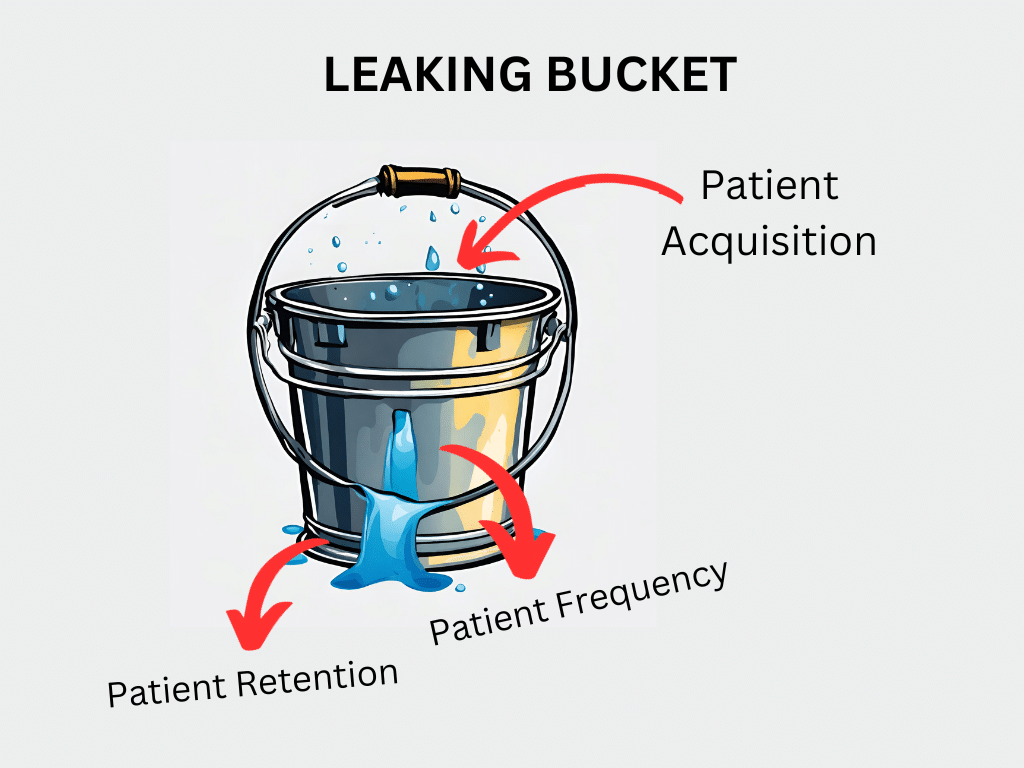I couldn’t believe the data staring back at me.
This patient marketing project suggested that most patients were casual ones, booking appointments once or twice per year because life forces them to.
But, a few smaller groups shocked me…
These patients had TENS of visits every year, each!
… I had to figure out what was going on.
As I dove deeper, I discovered that these smaller groups made up about a third of all the appointments.
Crazy.
… and quite misleading, had I built marketing campaigns assuming that every patient would visit the clinics roughly the same number of times each year.
Join me in this article, as I’ll dive into an often-overlooked patient growth lever that can produce significant growth for your clinics and ideas you can steal and implement for yourself.
Table of Contents
The powerful but overlooked growth lever in patient marketing
Patient marketing contains so many activities that it’s hard to pick a place to begin. I like to start backward, with the results I’m looking for, and then figure out which growth levers can help me get there.
Getting more patients in the door is one lever that can solve most business problems, and marketers love the straightforwardness of patient acquisition.
Consider this: if conversion tracking and HIPAA compliance give you a headache, you could run ads to the locations page of your website for nearby neighborhoods without having to worry about HIPAA at all.
Heck, you could even run ads to your booking page without tracking, as long as the CRM system protecting your leads or bookings is HIPAA compliant.
It feels simpler than the murky waters of retargeting existing patients… But going hard on patient acquisition before fixing problems further down the funnel is like filling water in a leaking bucket.

Your campaigns don’t perform as well as they could have since you can’t pay as much to acquire each new patient due to their lower value to the business.
That leaky bucket contains two other growth levers: patient frequency and retention.
I look at patient retention as staying the preferred clinic in the minds of your patients, whereas frequency is the number of times patients visit the clinic.
Increasing the frequency is a trifecta of the type of services our clinic offers, a good patient experience, and patient marketing
The trap of patient frequency and direct-to-patient marketing
When I first began working with patient marketing, I naively assumed that the doctor would recommend a follow-up visit when relevant and that was it.
With more experience, I’ve learned that patients don’t always agree and some even want a second opinion somewhere else. If you’ve ever tried persuading someone (or been persuaded yourself) to take vitamin pills, you know how difficult it is to change someone’s behavior without motivation.
There are certain specialties, services, and demographics that lend themselves more naturally to follow-ups than others. Compare a middle-aged woman having eye issues to a young man having flu symptoms, for example.
When you’re first looking at your existing patient frequency, it’ll be tempting to stick with the average number of completed appointments per patient and imagine what it would be like to double that number.
We’ll proceed to create generic campaigns offering discounts with some results here and there. As a result, our operating margins and NPS score go down, and the campaign trades sideways with unpredictable results.
That is the trap of patient frequency.
It’s not that easy; as crazy as it sounds, that is good news.
Your competitors are likely to stop their patient marketing there. If you go the extra step and segment your patients, I bet you’ll discover something similar to my story from earlier.
Our patient base is usually more nuanced than what first meets the eye: we’ll have many flaky patients with one-off bookings who don’t have a reason for completing appointments often. If you ask them, you might discover that they simply don’t care as much about managing their health unless their head is falling off.

Convincing them to come in more often is a huge effort that’ll likely fall on deaf ears. Even with discounts.
On the other hand, I bet you’ll also discover other subsegments that are highly motivated to book another appointment, like families with chronic diseases wanting to get other family members checked for the same.
It’s difficult for me to share specific pointers on how best to segment your data. I’ve found it to work best as an explorative task that we have to go into with an open mind and let the data show us each segment and its characteristics.
With the segments laid out, you’ll usually find that the best patient marketing strategies for each group become obvious. In the next chapter, I’ll share ideas to get your creative juices flowing.
HIPAA-compliant patient marketing strategies to increase frequency
Frequency is a growth lever within patient marketing and within that, we’ll find several sub-levers that we can move to reach our goal. Kinda like the Russian Matryoshka doll.

One of these is cross-selling and upselling, such as offering a dental exam to a patient who previously had an eye care appointment. It’s powerful but becomes tricky with existing patients as complying with HIPAA means we have to get each patient’s signature allowing us to market to them.
If we don’t, we’ll likely run into a lawsuit like a hospital did when they used Facebook’s retargeting pixel on pages within their patient portal without permission.
Instead, let’s look at less obvious creative ideas you can steal for your patient marketing to increase the frequency of your patients.
Retarget interested users nearby
Not all digital ad campaigns are protected by HIPAA. You can run Facebook retargeting ads to people who visited your homepage and are near your clinics, and send them to your locations page.
Under normal circumstances, both are considered standard business pages and thus don’t fall under HIPAA protection.
To be on the safe side, do take note of what’s on your homepage. If that is information that falls under personal health information (PHI) and thus needs HIPAA-compliant tracking software.
Remind interested parties about your brand
Another option is running Facebook retargeting ads to people who visited the homepage or locations page, and sending them to your about-us page to help them familiarize themselves with your brand.
Psychology theory (and advertising) suggests that prospects have to see your brand seven times on average before they convert, so this is an easy way to get some repetitions in without worrying about HIPAA, as you’ll reach both new and existing patients.
These pages are also standard business pages that aren’t protected by HIPAA as I described above.
Push seasonal or even-based preventive care
Some periods of the year lend themselves better to patient marketing than others. Pushing the flu vaccine during fall is a great example.
You can highlight events like health screenings or even specific campaigns tied to important health observances. For many patients, the feeling of completing an exam without issues is a huge relief after being concerned before going in. That feeling of dodging a bullet gets better the older you get.
The more often they have this experience, the more comfortable they become getting examinations, which ultimately helps them manage their health better.
In the long run that is a major indirect component of increasing the frequency of your patients. Especially, because, for those patients who tend to avoid getting seen by a physician until things get too bad, the trajectory is naturally going the other way.
By creating a sense of occasion around these appointments, you’ll engage patients in a meaningful way and encourage them to take an active role in managing their health.
Create second-opinion packages
Some patients like to get second opinions on their diagnosis before moving forward with a procedure.
Offering a partner program with second opinion packages from physicians at partner clinics can be an attractive alternative to the patient going somewhere else to do the same thing.
You’re making it easier for the patient while increasing the frequency of bookings. Your partners will send you second-opinion patients while you gain a cut on the ones you send the other way.
Getting the right patients will naturally increase the frequency
An entirely different way of approaching this is driving patients in the door who are likely to go for check-ups more often than average.
You’ll know what these patients look like for you by going through the segmentation task from earlier and focusing on the characteristics of the patients that seem the most attractive to you.
You might find that certain life events recently took place and triggered this. If you can figure out what those are, you can use it both in your marketing material and in the targeting on many platforms to drive new patients.
For example, if you know that newlyweds are likely to have a child soon, you might target those with digital ads and offer them a genetics test to understand if there are any reasons to avoid it.
Takeaways
- Patient marketing comes with powerful growth levers like acquisition, frequency, and retention
- Frequency is often overlooked, yet an effective way to grow your clinics provided you’re able to segment your patients to understand which type to see more of
- Some types of patients will be easy to get back to the clinic while others, less so. Avoid the temptation of running a generic campaign with a discount
Patient marketing is communicating with patients, often in order to increase brand awareness or drive more bookings.
Digital ads and organic traffic are among the most cost-effective channels for patient marketing.
Patient engagement marketing is focused on re-engaging existing patients as opposed to getting new patients through the door.
Existing patients are heavily protected by HIPAA and it’s critical to be compliant to avoid getting in trouble with the law. In this article, I share strategies you can use to increase the number of times patients visit your facility.
